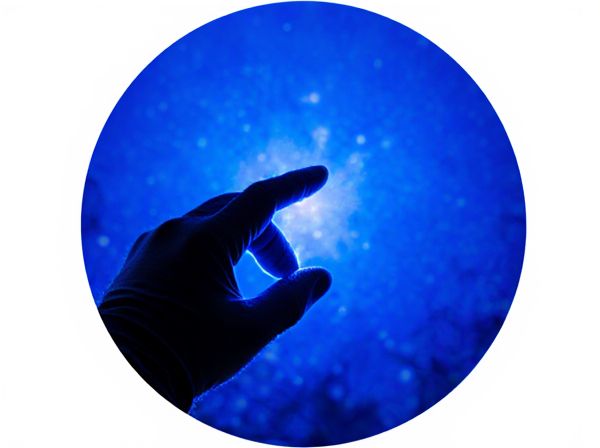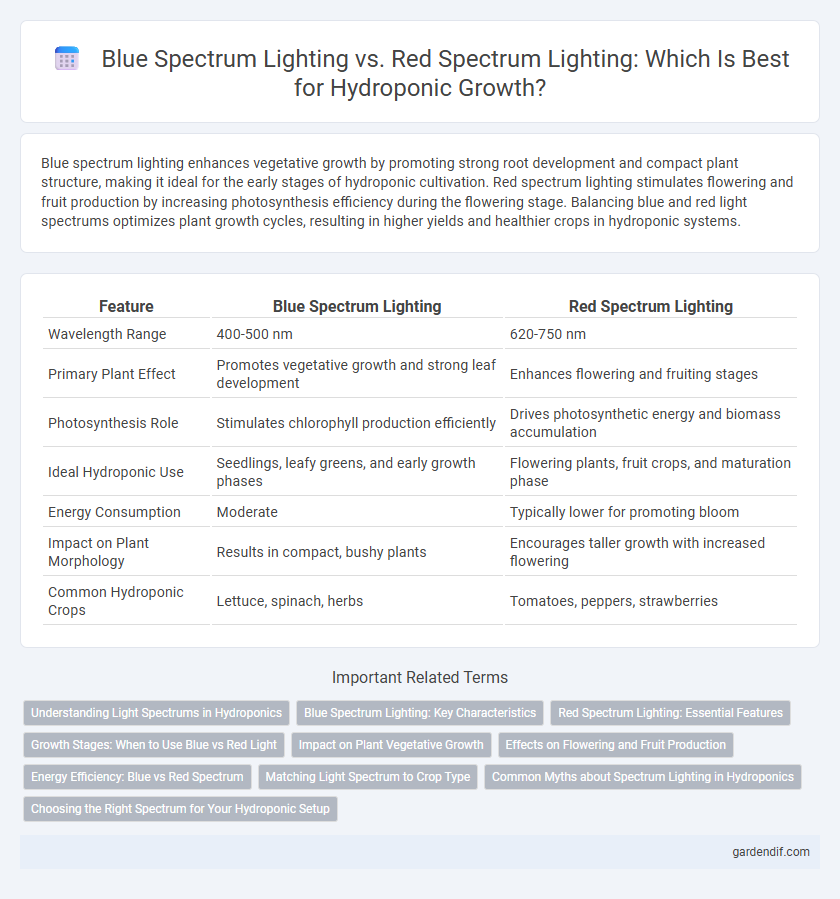
Blue Spectrum Lighting vs Red Spectrum Lighting Illustration
Blue spectrum lighting enhances vegetative growth by promoting strong root development and compact plant structure, making it ideal for the early stages of hydroponic cultivation. Red spectrum lighting stimulates flowering and fruit production by increasing photosynthesis efficiency during the flowering stage. Balancing blue and red light spectrums optimizes plant growth cycles, resulting in higher yields and healthier crops in hydroponic systems.
Table of Comparison
| Feature | Blue Spectrum Lighting | Red Spectrum Lighting |
|---|---|---|
| Wavelength Range | 400-500 nm | 620-750 nm |
| Primary Plant Effect | Promotes vegetative growth and strong leaf development | Enhances flowering and fruiting stages |
| Photosynthesis Role | Stimulates chlorophyll production efficiently | Drives photosynthetic energy and biomass accumulation |
| Ideal Hydroponic Use | Seedlings, leafy greens, and early growth phases | Flowering plants, fruit crops, and maturation phase |
| Energy Consumption | Moderate | Typically lower for promoting bloom |
| Impact on Plant Morphology | Results in compact, bushy plants | Encourages taller growth with increased flowering |
| Common Hydroponic Crops | Lettuce, spinach, herbs | Tomatoes, peppers, strawberries |
Understanding Light Spectrums in Hydroponics
Blue spectrum lighting in hydroponics promotes vegetative growth by enhancing chlorophyll production and leaf development, essential for strong plant structure. Red spectrum lighting stimulates flowering and fruiting phases, influencing photoperiodic responses and boosting photosynthesis efficiency. Understanding the balance and combination of blue and red light spectrums optimizes plant growth cycles and maximizes yield in hydroponic systems.
Blue Spectrum Lighting: Key Characteristics
Blue spectrum lighting in hydroponics stimulates vegetative growth by enhancing chlorophyll production and promoting strong root development. It typically ranges from 400 to 500 nanometers in wavelength, crucial for regulating photosynthesis and influencing plant morphology. This spectrum improves leaf thickness and overall plant health, making it essential during the early growth stages in controlled environment agriculture.
Red Spectrum Lighting: Essential Features
Red spectrum lighting, primarily in the 620-750 nm wavelength range, is essential for promoting flowering and fruiting stages in hydroponic plants. It enhances photosynthesis efficiency by stimulating chlorophyll production and regulating plant hormones associated with blooming. This lighting spectrum supports robust plant growth cycles, increasing yield quality and optimizing energy consumption in controlled indoor vegetable and fruit cultivation.
Growth Stages: When to Use Blue vs Red Light
Blue spectrum lighting supports vegetative growth by promoting strong stem and leaf development, making it ideal during the early growth stages of hydroponic plants. Red spectrum lighting enhances flowering and fruiting phases, stimulating bud formation and maximizing yield during the reproductive stage. Optimizing the light spectrum according to growth stages improves photosynthesis efficiency and overall plant health in hydroponic systems.
Impact on Plant Vegetative Growth
Blue spectrum lighting enhances vegetative growth by promoting chlorophyll production and leaf development, which leads to stronger, denser foliage. Red spectrum lighting primarily influences stem elongation and flowering initiation but is less effective in stimulating robust leaf growth during the vegetative phase. Optimal hydroponic systems often combine blue and red light to balance biomass accumulation and healthy plant structure.
Effects on Flowering and Fruit Production
Blue spectrum lighting enhances vegetative growth by promoting strong stem development and leaf expansion, which indirectly supports a healthy flowering phase. Red spectrum lighting directly stimulates flowering and fruit production by triggering flowering hormones and increasing blossom size and number. Combining blue and red spectrums in hydroponic systems optimizes overall plant health, maximizing both flowering intensity and fruit yield.
Energy Efficiency: Blue vs Red Spectrum
Blue spectrum lighting exhibits higher energy efficiency in hydroponic systems due to its shorter wavelengths, which require less electrical power to stimulate photosynthesis effectively. Red spectrum lighting, while essential for flowering and fruiting stages, often consumes more energy to produce the longer wavelengths necessary for these growth phases. Optimizing the balance between blue and red spectra can lead to significant energy savings and improved plant growth performance in hydroponic setups.
Matching Light Spectrum to Crop Type
Blue spectrum lighting enhances vegetative growth by promoting leaf development and strong root systems, making it ideal for leafy greens and herbs. Red spectrum lighting stimulates flowering and fruiting, which suits fruiting plants like tomatoes and peppers. Matching light spectrum to crop type optimizes photosynthesis efficiency and maximizes yield quality.
Common Myths about Spectrum Lighting in Hydroponics
Blue spectrum lighting in hydroponics is often misunderstood to stunt plant growth, but it primarily promotes vegetative development and strong root formation. Red spectrum lighting is mistakenly believed to only influence flowering stages, while it also plays a crucial role in photosynthesis efficiency and stem elongation. Common myths overlook that an optimal hydroponic setup combines both blue and red light spectra to maximize plant health and yield.
Choosing the Right Spectrum for Your Hydroponic Setup
Blue spectrum lighting enhances vegetative growth by promoting strong stem and leaf development in hydroponic plants, making it ideal for early growth stages. Red spectrum lighting stimulates flowering and fruiting, accelerating the transition from vegetative to reproductive phases in hydroponics. Selecting the appropriate light spectrum depends on the growth stage and crop type, optimizing photosynthesis efficiency and overall yield in hydroponic systems.
Blue Spectrum Lighting vs Red Spectrum Lighting Infographic

 gardendif.com
gardendif.com